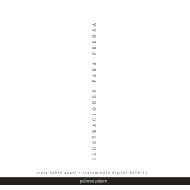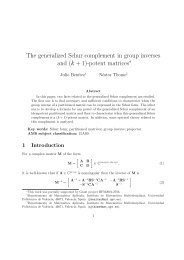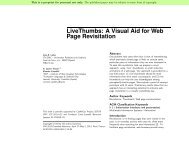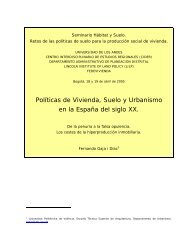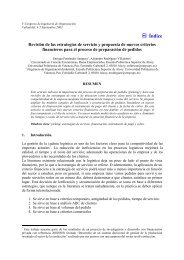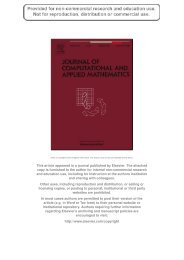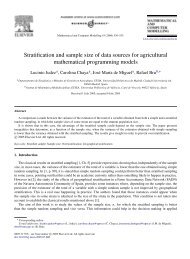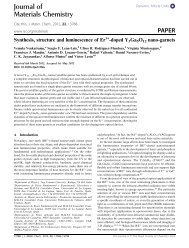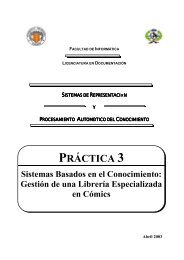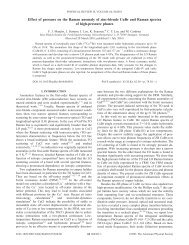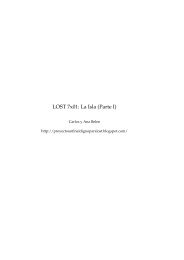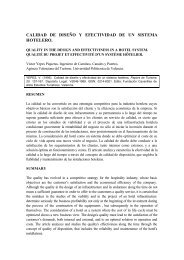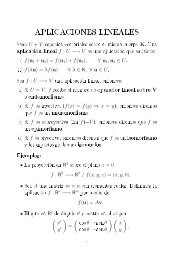Introduction to the resistivity surveying method. The resistivity of ...
Introduction to the resistivity surveying method. The resistivity of ...
Introduction to the resistivity surveying method. The resistivity of ...
Create successful ePaper yourself
Turn your PDF publications into a flip-book with our unique Google optimized e-Paper software.
43<br />
<strong>The</strong> free 3-D <strong>resistivity</strong> forward modeling program, RES3DMOD.EXE, enables you<br />
<strong>to</strong> calculate <strong>the</strong> apparent <strong>resistivity</strong> values for a survey with a rectangular grid <strong>of</strong> electrodes<br />
over a 3-D structure. This is a Windows based program that can be used from within<br />
Windows 3.1 or Windows 95/98/NT. To take a look <strong>the</strong> operation <strong>of</strong> <strong>the</strong> program, use <strong>the</strong><br />
“File” option followed by “Read model data” <strong>to</strong> read in <strong>the</strong> file BLOCK11X.MOD, which has<br />
a 11 by 11 survey grid. After that, click <strong>the</strong> “Edit/Display” option. To modify <strong>the</strong> 3-D model,<br />
click <strong>the</strong> “Edit <strong>resistivity</strong> model” option. In this option, you can change <strong>the</strong> <strong>resistivity</strong> <strong>of</strong> <strong>the</strong><br />
3-D cells in <strong>the</strong> mesh used by <strong>the</strong> finite-difference <strong>method</strong> (Dey and Morrison 1979b) <strong>to</strong><br />
calculate <strong>the</strong> apparent <strong>resistivity</strong> values. To quit from <strong>the</strong> “Edit” mode, press <strong>the</strong> Q or <strong>the</strong> Esc<br />
key. To calculate <strong>the</strong> apparent <strong>resistivity</strong> values, click <strong>the</strong> “Calculate” option. To take a look<br />
at <strong>the</strong> apparent <strong>resistivity</strong> pseudosections, click <strong>the</strong> “Display apparent <strong>resistivity</strong>” option. You<br />
can choose <strong>to</strong> display <strong>the</strong> apparent <strong>resistivity</strong> values in <strong>the</strong> form <strong>of</strong> horizontal pseudosections,<br />
or as vertical pseudosections as used in 2-D surveys. Displaying <strong>the</strong> vertical pseudosections<br />
will give you an idea <strong>of</strong> <strong>the</strong> effect <strong>of</strong> a 3-D structure on <strong>the</strong> measurements in a 2-D survey. A<br />
discussion <strong>of</strong> <strong>the</strong> sensitivity <strong>of</strong> different arrays <strong>to</strong> 3-D effects was given in <strong>the</strong> paper by Dahlin<br />
and Loke (1997). In general, it was found that for <strong>the</strong> models and arrays tested, <strong>the</strong> dipoledipole<br />
array was <strong>the</strong> most sensitive <strong>to</strong> 3-D effects while <strong>the</strong> Wenner array was <strong>the</strong> least<br />
sensitive.<br />
<strong>The</strong> RES3DMOD program also has an option <strong>to</strong> save <strong>the</strong> apparent <strong>resistivity</strong> values<br />
in<strong>to</strong> a format that can be accepted by <strong>the</strong> RES3DINV inversion program. As an exercise, save<br />
<strong>the</strong> apparent <strong>resistivity</strong> values as a RES3DINV data file for one <strong>of</strong> <strong>the</strong> models, and later carry<br />
out an inversion <strong>of</strong> this syn<strong>the</strong>tic data set.<br />
Figure 32a shows an example <strong>of</strong> a 3-D model with a 15 by 15 survey grid (i.e. 255<br />
electrodes). <strong>The</strong> model, which consists <strong>of</strong> four rectangular blocks embedded in a medium<br />
with a <strong>resistivity</strong> <strong>of</strong> 50 ohm.m, is shown in <strong>the</strong> form <strong>of</strong> horizontal slices through <strong>the</strong> earth.<br />
<strong>The</strong> apparent <strong>resistivity</strong> values for <strong>the</strong> pole-pole array (with <strong>the</strong> electrodes aligned in <strong>the</strong> x-<br />
direction) is shown in <strong>the</strong> form <strong>of</strong> horizontal pseudosections in Figure 32b. Note <strong>the</strong> low<br />
<strong>resistivity</strong> block with a <strong>resistivity</strong> <strong>of</strong> 10 ohm.m near <strong>the</strong> centre <strong>of</strong> <strong>the</strong> grid that extends from a<br />
depth <strong>of</strong> 1.0 <strong>to</strong> 3.2 metres. For measurements with <strong>the</strong> shorter electrode spacings <strong>of</strong> less than<br />
4 metres this block causes a low <strong>resistivity</strong> anomaly. However, for electrode spacings <strong>of</strong><br />
greater than 6 metres, this low <strong>resistivity</strong> block causes a high <strong>resistivity</strong> anomaly! This is an<br />
example <strong>of</strong> “anomaly inversion” which is caused by <strong>the</strong> near-surface zone <strong>of</strong> negative<br />
sensitivity values between <strong>the</strong> C1 and P1 electrodes (Figure 11).<br />
3.5 Data inversion<br />
One model used <strong>to</strong> interpret <strong>the</strong> 3-D data set is shown in Figure 33a. <strong>The</strong> subsurface is<br />
divided in<strong>to</strong> several layers and each layer is fur<strong>the</strong>r subdivided in<strong>to</strong> a number <strong>of</strong> rectangular<br />
blocks. A 3-D <strong>resistivity</strong> inversion program, RES3DINV, is used <strong>to</strong> interpret <strong>the</strong> data from 3-<br />
D surveys. This program attempts <strong>to</strong> determine <strong>the</strong> <strong>resistivity</strong> <strong>of</strong> <strong>the</strong> blocks in <strong>the</strong> inversion<br />
model that will most closely reproduce <strong>the</strong> measured apparent <strong>resistivity</strong> values from <strong>the</strong> field<br />
survey. Within <strong>the</strong> RES3DINV program, <strong>the</strong> thickness <strong>of</strong> <strong>the</strong> layers can be modified by <strong>the</strong><br />
user. Two o<strong>the</strong>r alternative models which can be used with <strong>the</strong> RES3DINV program are<br />
shown in Figures 33b and 33c. <strong>The</strong> second inversion model subdivides <strong>the</strong> <strong>to</strong>p few layers<br />
vertically as well as horizontally by half. Ano<strong>the</strong>r alternative is <strong>to</strong> subdivide <strong>the</strong> <strong>to</strong>p few layers<br />
by half only in <strong>the</strong> horizontal directions (Figure 33c). Since <strong>the</strong> resolution <strong>of</strong> <strong>the</strong> <strong>resistivity</strong><br />
<strong>method</strong> decreases rapidly with depth, it has been found that subdividing <strong>the</strong> blocks is only<br />
beneficial for <strong>the</strong> <strong>to</strong>p two layers only. In many cases, subdividing <strong>the</strong> <strong>to</strong>p layer only is enough.<br />
By subdividing <strong>the</strong> blocks, <strong>the</strong> number <strong>of</strong> model parameters and thus <strong>the</strong> computer time<br />
required <strong>to</strong> invert <strong>the</strong> data set can increase dramatically.<br />
Copyright (1999-2001) M.H.Loke



